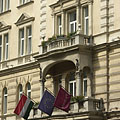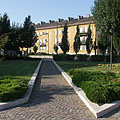(Оптимизован за уређаје са малим екранима)
Szent István University - Gödöllő, Мађарска
Када кликнете:
Кликните на сликама!
-
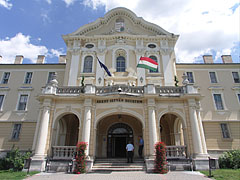
Entrance of the Szent István University of Gödöllő
Датум фотографисања: 09. 07. 2009.2009
Цреатед би: Robert Németh
Модел фотоапарата: Konica Minolta Dimage A200
Gödöllő, Мађарска
-
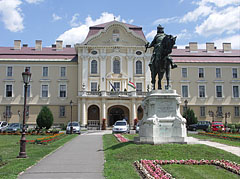
The main building of the Gödöllő campus of the Szent István University
This is the building of the former St. Norbert High School of the Norbertine or Premonstratensian Order.
Датум фотографисања: 09. 07. 2009.2009
Цреатед би: Robert Németh
Модел фотоапарата: Konica Minolta Dimage A200
Gödöllő, Мађарска
-
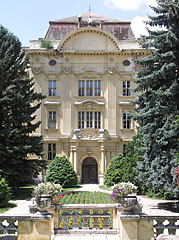
Szent István University of Gödöllő, the inner courtyard and garden
Датум фотографисања: 09. 07. 2009.2009
Цреатед би: Robert Németh
Модел фотоапарата: Konica Minolta Dimage A200
Gödöllő, Мађарска
-
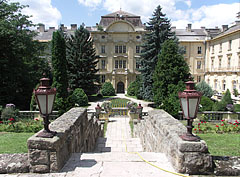
The courtyard of Szent István University can humble even some castles
Датум фотографисања: 09. 07. 2009.2009
Цреатед би: Robert Németh
Модел фотоапарата: Konica Minolta Dimage A200
Gödöllő, Мађарска
-
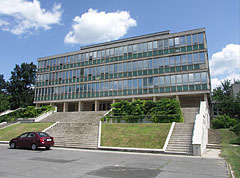
Szent István University of Gödöllő, socialist realist building of the Mechanical Engineering Faculty
Датум фотографисања: 09. 07. 2009.2009
Цреатед би: Robert Németh
Модел фотоапарата: Konica Minolta Dimage A200
Gödöllő, Мађарска
-
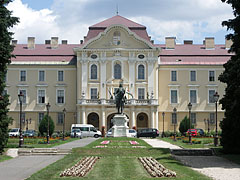
Szent István University of Gödöllő (SZIE)
Датум фотографисања: 09. 07. 2009.2009
Цреатед би: Robert Németh
Модел фотоапарата: Konica Minolta Dimage A200
Gödöllő, Мађарска
-
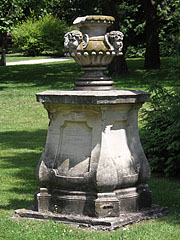
Sculpture at the park near Szent István University of Gödöllő
Датум фотографисања: 09. 07. 2009.2009
Цреатед би: Robert Németh
Модел фотоапарата: Konica Minolta Dimage A200
Gödöllő, Мађарска
-

Equestrian statue of Coloman Prince of Galicia-Lodomeria (1208-1241) at the Szent István University of Gödöllő
Датум фотографисања: 09. 07. 2009.2009
Цреатед би: Robert Németh
Модел фотоапарата: Konica Minolta Dimage A200
Gödöllő, Мађарска
-
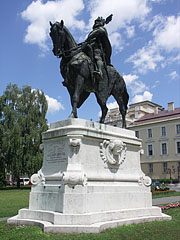
Equestrian statue of Coloman Prince of Galicia-Lodomeria near the Szent István University of Gödöllő (former Norbertine monastery)
The statue was created by József Róna, stands here since 1931.
Датум фотографисања: 09. 07. 2009.2009
Цреатед би: Robert Németh
Модел фотоапарата: Konica Minolta Dimage A200
Gödöllő, Мађарска
-
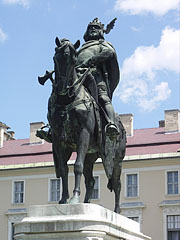
Equestrian statue of Coloman Prince of Galicia-Lodomeria near Szent István University of Gödöllő
Датум фотографисања: 09. 07. 2009.2009
Цреатед би: Robert Németh
Модел фотоапарата: Konica Minolta Dimage A200
Gödöllő, Мађарска
-
Szent István University of Gödöllő, from the courtyard
Датум фотографисања: 09. 07. 2009.2009
Цреатед би: Robert Németh
Модел фотоапарата: Konica Minolta Dimage A200
Gödöllő, Мађарска
Szent István University of Gödöllő, from the courtyard - Gödöllő, Мађарска -
Szent István University of Gödöllő, babbling well in the courtyard
Датум фотографисања: 09. 07. 2009.2009
Цреатед би: Robert Németh
Модел фотоапарата: Konica Minolta Dimage A200
Gödöllő, Мађарска
Szent István University of Gödöllő, babbling well in the courtyard - Gödöllő, Мађарска -
Szent István University of Gödöllő, babbling well in the courtyard
Датум фотографисања: 09. 07. 2009.2009
Цреатед би: Robert Németh
Модел фотоапарата: Konica Minolta Dimage A200
Gödöllő, Мађарска
Szent István University of Gödöllő, babbling well in the courtyard - Gödöllő, Мађарска -
Szent István University of Gödöllő, babbling well in the courtyard
Датум фотографисања: 09. 07. 2009.2009
Цреатед би: Robert Németh
Модел фотоапарата: Konica Minolta Dimage A200
Gödöllő, Мађарска
Szent István University of Gödöllő, babbling well in the courtyard - Gödöllő, Мађарска -
Szent István University of Gödöllő, the moody terrace of the snack bar
Датум фотографисања: 09. 07. 2009.2009
Цреатед би: Robert Németh
Модел фотоапарата: Konica Minolta Dimage A200
Gödöllő, Мађарска
Szent István University of Gödöllő, the moody terrace of the snack bar - Gödöllő, Мађарска -
Szent István University of Gödöllő, moody terrace of the cafeteria and snack bar
Датум фотографисања: 09. 07. 2009.2009
Цреатед би: Robert Németh
Модел фотоапарата: Konica Minolta Dimage A200
Gödöllő, Мађарска
Szent István University of Gödöllő, moody terrace of the cafeteria and snack bar - Gödöllő, Мађарска -
Szent István University of Gödöllő
Датум фотографисања: 09. 07. 2009.2009
Цреатед би: Robert Németh
Модел фотоапарата: Konica Minolta Dimage A200
Gödöllő, Мађарска
Szent István University of Gödöllő - Gödöllő, Мађарска -
Terraced inner garden of Szent István University of Gödöllő
Датум фотографисања: 09. 07. 2009.2009
Цреатед би: Robert Németh
Модел фотоапарата: Konica Minolta Dimage A200
Gödöllő, Мађарска
Terraced inner garden of Szent István University of Gödöllő - Gödöllő, Мађарска -
Magnificent inner court of Szent István University
Датум фотографисања: 09. 07. 2009.2009
Цреатед би: Robert Németh
Модел фотоапарата: Konica Minolta Dimage A200
Gödöllő, Мађарска
Magnificent inner court of Szent István University - Gödöllő, Мађарска -
The spectacular inner courtyard of Szent István University
Датум фотографисања: 09. 07. 2009.2009
Цреатед би: Robert Németh
Модел фотоапарата: Konica Minolta Dimage A200
Gödöllő, Мађарска
The spectacular inner courtyard of Szent István University - Gödöllő, Мађарска -
Szent István University of Gödöllő, hall of the Mechanical Engineering Faculty
Датум фотографисања: 09. 07. 2009.2009
Цреатед би: Robert Németh
Модел фотоапарата: Konica Minolta Dimage A200
Gödöllő, Мађарска
Szent István University of Gödöllő, hall of the Mechanical Engineering Faculty - Gödöllő, Мађарска -
The snack bar terrace of the university in the inner courtyard
Датум фотографисања: 09. 07. 2009.2009
Цреатед би: Robert Németh
Модел фотоапарата: Konica Minolta Dimage A200
Gödöllő, Мађарска
The snack bar terrace of the university in the inner courtyard - Gödöllő, Мађарска -
The central part of the main building, viewed from the inner courtyard and garden
Датум фотографисања: 09. 07. 2009.2009
Цреатед би: Robert Németh
Модел фотоапарата: Konica Minolta Dimage A200
Gödöllő, Мађарска
The central part of the main building, viewed from the inner courtyard and garden - Gödöllő, Мађарска -
The inner courtyard of the Szent István University of Gödöllő
Датум фотографисања: 09. 07. 2009.2009
Цреатед би: Robert Németh
Модел фотоапарата: Konica Minolta Dimage A200
Gödöllő, Мађарска
The inner courtyard of the Szent István University of Gödöllő - Gödöllő, Мађарска -
The inner courtyard within the main building of the Szent István University of Gödöllő
Датум фотографисања: 09. 07. 2009.2009
Цреатед би: Robert Németh
Модел фотоапарата: Konica Minolta Dimage A200
Gödöllő, Мађарска
The inner courtyard within the main building of the Szent István University of Gödöllő - Gödöllő, Мађарска -
"The apotheosis of the nucleus", giant bronze relief in the function hall or aula of the Mechanical Engineering Faculty
Created by Amerigo Tot in 1980
Датум фотографисања: 09. 07. 2009.2009
Цреатед би: Robert Németh
Модел фотоапарата: Konica Minolta Dimage A200
Gödöllő, Мађарска
"The apotheosis of the nucleus", giant bronze relief in the function hall or aula of the Mechanical Engineering Faculty - Gödöllő, Мађарска -
The so-called "Iron Tree" (in Hungarian "Vasfa"), a tree trunk with memorial plaques of the graduating students
The name is coming from the iron nails that are used to fasten the small metal plaques on the trunk since many years.
Датум фотографисања: 09. 07. 2009.2009
Цреатед би: Robert Németh
Модел фотоапарата: Konica Minolta Dimage A200
Gödöllő, Мађарска
The so-called "Iron Tree" (in Hungarian "Vasfa"), a tree trunk with memorial plaques of the graduating students - Gödöllő, Мађарска -
The stone vase with the putto heads stands here in the park since 1925
Just to mention, despite the fact that they are often represented with wings the putti or puttoes are not angels, just naked chubby male children.
Датум фотографисања: 09. 07. 2009.2009
Цреатед би: Robert Németh
Модел фотоапарата: Konica Minolta Dimage A200
Gödöllő, Мађарска
The stone vase with the putto heads stands here in the park since 1925 - Gödöllő, Мађарска -
The main building of the Szent István University (SZIE) Gödöllő campus
Formerly it was called Gödöllő University of Agricultural Sciences, before it was merged with other universities and colleges.
Датум фотографисања: 09. 07. 2009.2009
Цреатед би: Robert Németh
Модел фотоапарата: Konica Minolta Dimage A200
Gödöllő, Мађарска
The main building of the Szent István University (SZIE) Gödöllő campus - Gödöllő, Мађарска -
The main building of the Szent István University of Gödöllő (abbreviated as SZIE)
Датум фотографисања: 09. 07. 2009.2009
Цреатед би: Robert Németh
Модел фотоапарата: Konica Minolta Dimage A200
Gödöllő, Мађарска
The main building of the Szent István University of Gödöllő (abbreviated as SZIE) - Gödöllő, Мађарска -
The inner courtyard and garden of the Szent István University of Gödöllő
Датум фотографисања: 27. 06. 2012.2012
Цреатед би: Robert Németh
Модел фотоапарата: Konica Minolta Dimage A200
Gödöllő, Мађарска
The inner courtyard and garden of the Szent István University of Gödöllő - Gödöllő, Мађарска -
Babbling fountain in the garden
Датум фотографисања: 27. 06. 2012.2012
Цреатед би: Robert Németh
Модел фотоапарата: Konica Minolta Dimage A200
Gödöllő, Мађарска
Babbling fountain in the garden - Gödöllő, Мађарска -
A babbling fountain in the garden of the university
Датум фотографисања: 27. 06. 2012.2012
Цреатед би: Robert Németh
Модел фотоапарата: Konica Minolta Dimage A200
Gödöllő, Мађарска
A babbling fountain in the garden of the university - Gödöllő, Мађарска -
Baroque style stone vases with flowers in the garden of the university
Датум фотографисања: 27. 06. 2012.2012
Цреатед би: Robert Németh
Модел фотоапарата: Konica Minolta Dimage A200
Gödöllő, Мађарска
Baroque style stone vases with flowers in the garden of the university - Gödöllő, Мађарска -
Fountain in the garden
Датум фотографисања: 27. 06. 2012.2012
Цреатед би: Robert Németh
Модел фотоапарата: Konica Minolta Dimage A200
Gödöllő, Мађарска
Fountain in the garden - Gödöllő, Мађарска -
"James, master of the Templars", portrait of Jacques de Molay templar knight on the pedestal of the equestrian statue in front of the university
Датум фотографисања: 27. 06. 2012.2012
Цреатед би: Robert Németh
Модел фотоапарата: Konica Minolta Dimage A200
Gödöllő, Мађарска
"James, master of the Templars", portrait of Jacques de Molay templar knight on the pedestal of the equestrian statue in front of the university - Gödöllő, Мађарска -
The Gödöllő dormitory of the Szent István University, one of the buildings and a parking lot
Датум фотографисања: 01. 05. 2014.2014
Цреатед би: Robert Németh
Модел фотоапарата: Konica Minolta Dimage A200
Gödöllő, Мађарска
The Gödöllő dormitory of the Szent István University, one of the buildings and a parking lot - Gödöllő, Мађарска -
Szent István University, a building of the dormitory (hostel) in Gödöllő
Датум фотографисања: 01. 05. 2014.2014
Цреатед би: Robert Németh
Модел фотоапарата: Konica Minolta Dimage A200
Gödöllő, Мађарска
Szent István University, a building of the dormitory (hostel) in Gödöllő - Gödöllő, Мађарска -
Vintage autobus
Датум фотографисања: 01. 05. 2014.2014
Цреатед би: Robert Németh
Модел фотоапарата: Konica Minolta Dimage A200
Gödöllő, Мађарска
Vintage autobus - Gödöllő, Мађарска -
An oldtimer bus turns to the direction of the dormitories
Датум фотографисања: 01. 05. 2014.2014
Цреатед би: Robert Németh
Модел фотоапарата: Konica Minolta Dimage A200
Gödöllő, Мађарска
An oldtimer bus turns to the direction of the dormitories - Gödöllő, Мађарска -
The "Life" or "Ear of Wheat" bronze sculpture in front of the Szent István University
Created by István Kiss in 1977
Датум фотографисања: 01. 05. 2014.2014
Цреатед би: Robert Németh
Модел фотоапарата: Konica Minolta Dimage A200
Gödöllő, Мађарска
The "Life" or "Ear of Wheat" bronze sculpture in front of the Szent István University - Gödöllő, Мађарска -
"Ear of Wheat" or "Wheat ear", bronze sculpture of István Kiss sculptor at the building of the Mechanical Engineering Faculty
Датум фотографисања: 01. 05. 2014.2014
Цреатед би: Robert Németh
Модел фотоапарата: Konica Minolta Dimage A200
Gödöllő, Мађарска
"Ear of Wheat" or "Wheat ear", bronze sculpture of István Kiss sculptor at the building of the Mechanical Engineering Faculty - Gödöllő, Мађарска -
The park in front of the Szent István University
Датум фотографисања: 01. 05. 2014.2014
Цреатед би: Robert Németh
Модел фотоапарата: Konica Minolta Dimage A200
Gödöllő, Мађарска
The park in front of the Szent István University - Gödöllő, Мађарска -
Szent István University of Gödöllő
Датум фотографисања: 01. 05. 2014.2014
Цреатед би: Robert Németh
Модел фотоапарата: Konica Minolta Dimage A200
Gödöllő, Мађарска
Szent István University of Gödöllő - Gödöllő, Мађарска -
Park at the main building of Gödöllő of the Szent István University
Датум фотографисања: 01. 05. 2014.2014
Цреатед би: Robert Németh
Модел фотоапарата: Konica Minolta Dimage A200
Gödöllő, Мађарска
Park at the main building of Gödöllő of the Szent István University - Gödöllő, Мађарска -
Szent István University (SZIA), the main building in Gödöllő
Датум фотографисања: 01. 05. 2014.2014
Цреатед би: Robert Németh
Модел фотоапарата: Konica Minolta Dimage A200
Gödöllő, Мађарска
Szent István University (SZIA), the main building in Gödöllő - Gödöllő, Мађарска -
The main building of the Szent István University (SZIE) in Gödöllő, in front of it in the park it is the equestrian statue of Prince Coloman of Galicia-Lodomeria
Датум фотографисања: 01. 05. 2014.2014
Цреатед би: Robert Németh
Модел фотоапарата: Konica Minolta Dimage A200
Gödöllő, Мађарска
The main building of the Szent István University (SZIE) in Gödöllő, in front of it in the park it is the equestrian statue of Prince Coloman of Galicia-Lodomeria - Gödöllő, Мађарска -
The main facade of the university, the middle risalit with the balcony
Датум фотографисања: 01. 05. 2014.2014
Цреатед би: Robert Németh
Модел фотоапарата: Konica Minolta Dimage A200
Gödöllő, Мађарска
The main facade of the university, the middle risalit with the balcony - Gödöllő, Мађарска -
Red tulips and other spring flowers in the park at the university
Датум фотографисања: 01. 05. 2014.2014
Цреатед би: Robert Németh
Модел фотоапарата: Konica Minolta Dimage A200
Gödöllő, Мађарска
Red tulips and other spring flowers in the park at the university - Gödöllő, Мађарска -
Szent István University (SZIE), the main building in Gödöllő
Датум фотографисања: 01. 05. 2014.2014
Цреатед би: Robert Németh
Модел фотоапарата: Konica Minolta Dimage A200
Gödöllő, Мађарска
Szent István University (SZIE), the main building in Gödöllő - Gödöllő, Мађарска -
Szent István University (SZIE), the main building in Gödöllő
Датум фотографисања: 01. 05. 2014.2014
Цреатед би: Robert Németh
Модел фотоапарата: Konica Minolta Dimage A200
Gödöllő, Мађарска
Szent István University (SZIE), the main building in Gödöllő - Gödöllő, Мађарска -
The coat of arms of Hungary on the facade of the University
Датум фотографисања: 01. 05. 2014.2014
Цреатед би: Robert Németh
Модел фотоапарата: Konica Minolta Dimage A200
Gödöllő, Мађарска
The coat of arms of Hungary on the facade of the University - Gödöllő, Мађарска -
The side wing of the main building of the university
Датум фотографисања: 01. 05. 2014.2014
Цреатед би: Robert Németh
Модел фотоапарата: Konica Minolta Dimage A200
Gödöllő, Мађарска
The side wing of the main building of the university - Gödöllő, Мађарска -
Pansy and forget-me-not flowers beside the main building of the university
Датум фотографисања: 01. 05. 2014.2014
Цреатед би: Robert Németh
Модел фотоапарата: Konica Minolta Dimage A200
Gödöllő, Мађарска
Pansy and forget-me-not flowers beside the main building of the university - Gödöllő, Мађарска -
The driveway of the main building
Датум фотографисања: 01. 05. 2014.2014
Цреатед би: Robert Németh
Модел фотоапарата: Konica Minolta Dimage A200
Gödöllő, Мађарска
The driveway of the main building - Gödöllő, Мађарска -
Flower bed beside the main building
Датум фотографисања: 01. 05. 2014.2014
Цреатед би: Robert Németh
Модел фотоапарата: Konica Minolta Dimage A200
Gödöllő, Мађарска
Flower bed beside the main building - Gödöllő, Мађарска -
Blue forget-me-not flowers
Датум фотографисања: 01. 05. 2014.2014
Цреатед би: Robert Németh
Модел фотоапарата: Konica Minolta Dimage A200
Gödöllő, Мађарска
Blue forget-me-not flowers - Gödöllő, Мађарска -
Tiny light blue forget-me-not flowers (Myosotis)
Датум фотографисања: 01. 05. 2014.2014
Цреатед би: Robert Németh
Модел фотоапарата: Konica Minolta Dimage A200
Gödöllő, Мађарска
Tiny light blue forget-me-not flowers (Myosotis) - Gödöllő, Мађарска -
Ornate three-way iron lamp post beside the university
Датум фотографисања: 01. 05. 2014.2014
Цреатед би: Robert Németh
Модел фотоапарата: Konica Minolta Dimage A200
Gödöllő, Мађарска
Ornate three-way iron lamp post beside the university - Gödöllő, Мађарска -
Three-way iron lamppost at the main building of the university
Датум фотографисања: 01. 05. 2014.2014
Цреатед би: Robert Németh
Модел фотоапарата: Konica Minolta Dimage A200
Gödöllő, Мађарска
Three-way iron lamppost at the main building of the university - Gödöllő, Мађарска -
The park of the university, and the building of the faculty of Mechanical Engineering on the right
Датум фотографисања: 01. 05. 2014.2014
Цреатед би: Robert Németh
Модел фотоапарата: Konica Minolta Dimage A200
Gödöllő, Мађарска
The park of the university, and the building of the faculty of Mechanical Engineering on the right - Gödöllő, Мађарска -
Park at the university, near the Mechanical Engineering Faculty building
Датум фотографисања: 01. 05. 2014.2014
Цреатед би: Robert Németh
Модел фотоапарата: Konica Minolta Dimage A200
Gödöllő, Мађарска
Park at the university, near the Mechanical Engineering Faculty building - Gödöllő, Мађарска -
The "B" dormitory building of the Szent István University
Датум фотографисања: 01. 05. 2014.2014
Цреатед би: Robert Németh
Модел фотоапарата: Konica Minolta Dimage A200
Gödöllő, Мађарска
The "B" dormitory building of the Szent István University - Gödöllő, Мађарска -
Szent István University, the "B" building of the dormitory
Датум фотографисања: 01. 05. 2014.2014
Цреатед би: Robert Németh
Модел фотоапарата: Konica Minolta Dimage A200
Gödöllő, Мађарска
Szent István University, the "B" building of the dormitory - Gödöllő, Мађарска
Кликните на сликама!
Карактеристике, особине
Положај:
ГПС координате: Ширина 47°35'34", Дужина 19°21'40" (N47 35.57 - E19 21.67)
Информације, кратке приче, занимљивих чињеница
 Equestrian statue of Coloman Prince of Galicia-Lodomeria (1208-1241) at the Szent István University of Gödöllő
Equestrian statue of Coloman Prince of Galicia-Lodomeria (1208-1241) at the Szent István University of Gödöllő
Prince Coloman (in Hungarian "Kálmán herceg") was ''the heroic offspring of the Árpád dynasty who was wounded to death in the Battle of Mohi", as the caption also says on the pedestal of the statue. His father was King Andrew II of Hungary (also known as Andrew II of Jerusalem, in Hungarian "II. András"), who enthroned the just six years old Coloman as the King of Galicia-Lodomeria (Halych-Volhynia) in 1214. Halych-Volhynia or also known as Galicia-Lodomeria (since Andrew II of Hungary) was a historical and geographic region in Central and Eastern Europe, its area is today divided by Poland and Ukrain. Coloman could bear the royal title until his death, although due to the uprisings in Halych he had to flee, but as a compensation he received Szepes County or earldom from his father. This way he came into contact with the Premonstratensian (Norbertine) monks, and he supported them by donations of money and land. In 1226 he became the duke of Slavonia, Croatia and Dalmatia, after his father King Andrew II took these provinces from his other son Béla (the later Béla IV of Hungary) and gave it to Coloman. However, at the same time Bela received Transylvania ("Erdély"). With this action Andrew II probably tried to stir up strife between the two brothers, his sons who turned against him, but surprisingly Coloman still cooperated with Béla and they together tried to take back the royal domains which regard them (because II. Andrew breached his former promises). Coloman went into the Battle of Mohi (or Muhi) against the Mongols as the head of the Croatian troops, but he was wounded and died here in 1241.
 Equestrian statue of Coloman Prince of Galicia-Lodomeria near Szent István University of Gödöllő
Equestrian statue of Coloman Prince of Galicia-Lodomeria near Szent István University of Gödöllő
Those who watch the statue from close up it is visible that the horse's belly, more specifically the nobler part between its legs is quite glittering. This is caused by the students of the university, who believe in the superstition that if they often touch this part of the statue, it ensures the successful exam. It would be interesting to check the statistics, if it really works or not...
 Entrance of the Szent István University of Gödöllő
Entrance of the Szent István University of Gödöllő
The current main building of the Szent István University was originally built for the Norbertine (Premonstratensian) religious order, but for educational reasons even from the beginning. Az 1920-as trianoni békeszerződés diktátuma következtében a premontrei szerzetesrend elvesztette a Románia kezébe kerülő Nagyvárad, valamint a Szlovákia (azaz akkor Csehszlovákia) határai mögé tolódó Kassa és Rozsnyó városok gimnáziumait. Jászóvár cseh területre került, az itteni rendfőnök kezdeményezte új intézet alapítását Magyarország új határain belül. Erre 1923-ban állami támogatásként Gödöllőn kaptak 88 hold földet az akkori Fácános-erdő területéből.
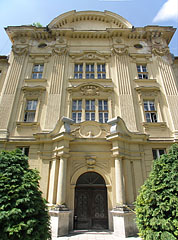 Szent István University of Gödöllő, from the courtyard
Szent István University of Gödöllő, from the courtyard
The neo-baroque style building complex was designed by Róber Kertész K. and Gyula Sváb. Firstly the secondary school (southern) wing was completed in 1924. One year later also the eastern wing was finished and inside it the St. Norbert Boarding School (in Hungarian "Szent Norbert Nevelőintézet") started its operation. The main (western) building with the monastery was completed and opened in 1928. In the past the interior was decorated by artworks of famous artist, for example Sándor Nagy, Ferenc Sidló and Zsigmond Kisfaludi Strobl.
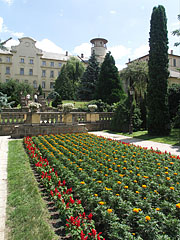 Terraced inner garden of Szent István University of Gödöllő
Terraced inner garden of Szent István University of Gödöllő
In 1933 the university (more precisely at that time the Premonstratensian or Norbertine institution) building was the residence of the leaders of the 4th World Scout Jamboree (world gathering of Boy Scouts).
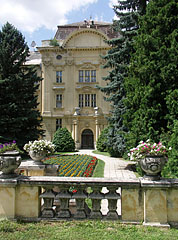 Magnificent inner court of Szent István University
Magnificent inner court of Szent István University
The World War II caused serious damages in the building, it was hit by more bombs as well. Firstly in 1944 it was used as a military hospital, then in 1945 the whole building complex became a detention center after the members of the Norbertine Order were moved to Máriabesnyő (it is today part of Gödöllő town).
 The courtyard of Szent István University can humble even some castles
The courtyard of Szent István University can humble even some castles
In 1948 the secondary school was deprivatized and in 1949 the government designated Gödöllő town for the higher education of the agricultural sciences. Complete university departments were moved here, and the university was expanded with more new buildings. Today it is the most advanced university of agricultural sciences in Hungary. Since 1992 one of the newer buildings is used by the Secondary Grammar School of the Norbertine Order again.
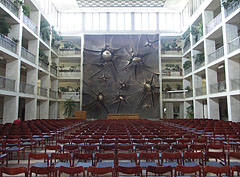 Szent István University of Gödöllő, hall of the Mechanical Engineering Faculty
Szent István University of Gödöllő, hall of the Mechanical Engineering Faculty
Since 1983 there is a large bronze relief inside the aula (function hall) of the Szent István University Mechanical Engineering Faculty. It is called "The apotheosis of the nucleus" and created in 1980 by the Amerigo Tot (1909-1984), Hungarian-born sculptor from Rome. This giant bronze relief is 120 square meters in size, but it also has a smaller replica in the arcades at 11 Kossuth Lajos Square, Budapest (this is the Ministry of Agriculture building).
Gödöllő - Више фото галерије:
Можете такође бити заинтересовани (Повезане странице):
Дестинације у туристичком водичу:
Gödöllő (834 фотографије + 2 панорамске слике)
Gödöllő Hills (Gödöllői-dombság) (4 203 фотографије + 21 панорамске слике)
Pest megye (county) (15 122 фотографије + 50 панорамске слике)
Будимпешта и њена околина (Централна Мађарска) (15 989 фотографије + 52 панорамске слике)
Мађарска (27 287 фотографије + 163 панорамске слике)
и додатно:
(у овде: Gödöllő Hills)
Fót (183 фотографије)
Isaszeg (171 фотографије)
Pécel (101 фотографије)
Tura (30 фотографије)
Veresegyház (365 фотографије)
Mogyoród (1 516 фотографије + 19 панорамске слике)
Szada (359 фотографије)
Tóalmás (79 фотографије)
Vácrátót (438 фотографије)
Свака панорамска слика овде:
Gödöllő (2 фотографије)
Gödöllő Hills (Gödöllői-dombság) (21 фотографије)
Pest megye (county) (50 фотографије)
Будимпешта и њена околина (Централна Мађарска) (52 фотографије)
Мађарска (163 фотографије)
Европа (165 фотографије)
Сваки нормални фото овде:
Gödöllő (834 фотографије / 10 галерије)
Gödöllő Hills (Gödöllői-dombság) (4 203 фотографије / 54 галерије)
Pest megye (county) (15 122 фотографије / 221 галерије)
Будимпешта и њена околина (Централна Мађарска) (15 989 фотографије / 234 галерије)
Мађарска (27 287 фотографије / 462 галерије)
Европа (30 494 фотографије / 523 галерије)
https://www.panadea.com/sr/guidebook/godollo/photos/gal-005

Додај у Фаворите Додај у Омиљене
Подели са својим пријатељима!
итд
О нама - Одрицање одговорности -
Сва права задржана
- ©2010-2022
Neuronit Creative Studio - Mogyoród / Будимпешта / Мађарска



